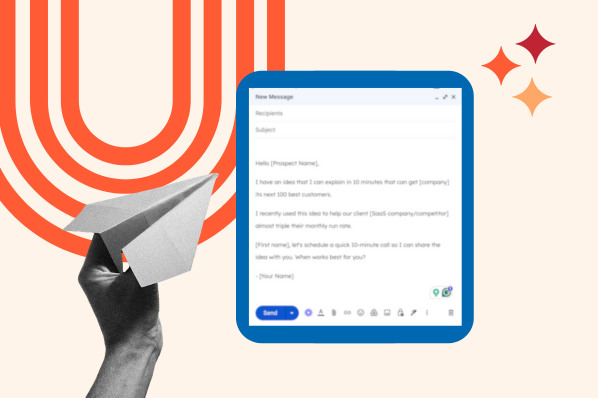Download These Templates for Free
1. Default to the idea that there are many reasons a prospect could have missed a call.
It’s easy to assume a no-show is the result of a flaky or ultra-busy prospect, then let that belief color the rest of your interactions with them. But the only assumption you can confidently make is that you can’t be 100% sure about what happened.
This mindset will help you avoid making inaccurate assumptions or jumping to conclusions.
2. Respond with an even tone.
You might be feeling negative feelings about the time you invested in the meeting only to have them show up. This is completely normal. At the same time, while this situation is an inconvenience, it's best not to let these negative feelings creep into your email.
We're all human, and we all make mistakes. Without knowing the circumstances (as described in the previous tip), it's not advisable to chastise the prospect. Plus, it's always best to keep things professional.
3. Don’t guilt trip the prospect.
Guilt-tripping makes people feel terrible, pushes them to do something they might not want to do, and doesn’t reflect well on you or the company you represent. The last thing you want to do is associate your outreach with a negative feeling where one didn't exist before.
Friendly nudges are fine. Sending out emotional sob stories meant to guilt a prospect aren’t.
4. Definitely don’t harass a prospect.
This seems like an incredibly obvious point to make, but you’d be surprised at the lengths some sales reps go to get ahold of a prospect. This includes calling alternative numbers found on LinkedIn profiles or emailing a prospect’s personal account.
While those might not seem like hugely offensive acts, consider how you feel when a sales reps takes an alternative route to reach you. Usually not all that great.
Creative forms of outreach are okay -- up to a certain point. Beyond that, they become frustrating for prospects and flirt with the line between persistence and harassment.
5. Be honest about what happened on your end.
If you weren’t able to reach a prospect by phone, tell them you weren’t able to reach them. If they never showed up to your Zoom, WebEx, or GoToMeeting, tell them.
Stating what happened outright helps you establish the facts from your perspective and avoid making “assumption” statements that aren’t all that motivating (e.g. “I assume you’ve got a really busy schedule, so I’d like to figure out a time we can reschedule.”)
6. Add the value you anticipated covering during the call in your follow-up email.
Any email you send to a prospect is an opportunity to provide value to your prospect.
Even when they don’t show up, take a minute and pretend they did. What information would you have covered? What types of materials or resources would have been helpful partner pieces to that conversation?
Share it. Sending resources gives your prospect an opportunity to educate themselves on why they should choose your product or service, as well as get up to speed on missed information without slowing down the process too much.
7. Propose a reschedule.
Unless your prospect tells you otherwise, it's likely they intended to attend the meeting but couldn't because something came up. Propose rescheduling the meeting so you can preserve the momentum of your previous calls, and use a scheduling app to reduce the number of unnecessary back-and-forth emails.
8. Be realistic if this happens more than once.
Your prospect's time is valuable -- but so is yours. If they reschedule or are a no-show three or more times, have an honest conversation with them about whether it's worth either party's time to continue.
A simple note saying, "Hey, we've tried to reschedule this meeting three times now. Usually when this happens, it means this isn't a priority for your company at the moment. Is this fair for me to assume in this case?"
You'll force an answer and a final move. Your prospect will either say, "No! Not at all. I've just had a really busy quarter." or "Actually, this isn't a priority right now. It's probably best to shelve this for the moment."
You'll get the answer you need to move forward either way.
Reschedule Meeting Email
Most sales reps have a basic follow-up email template to send to no-shows. It's usually something along the lines of, “We missed each other! Just following up to reschedule.”
While it’s not a bad thing to have, I wouldn’t rely on one short email exclusively. Templated, generic emails are easy to spot.
Here’s an email template you can use as a starting point. I highly suggest tweaking it to make it your own and adapting based on each situation:
Hi [Prospect],
I rang (XXX) XXX-XXXX at 3 p.m. today and it went straight to voicemail. I planned to cover Y and Z during today’s call, so I wanted to send over a couple pieces of information to catch you up. Take a look and let me know what questions you have!
- Link or file to piece #1
- Link or file to piece #2
Would you be interested in scheduling another call? I have a [link to meetings app] that should make it easy to select an open time.
Best,
[Your name]
In the above email, you've effectively:
- Stated the facts from your side
- Added value by providing resources
- Offered an opportunity to reschedule
Alternatively, if you have an already established and less formal relationship with a prospect, you might consider having fun with your follow-up:
Hi [Prospect],
I was unable to reach you for our scheduled meeting today. It freed up some unexpected space in my calendar, and I actually had time to clean my desk drawer for the first time in who knows how long. A geologist could probably measure the stratum of dust that had accumulated.
Joking aside, missed meetings happen, and I'm looking forward to reconvening. I planned to cover [topic] during today’s call, so here's some supplementary information about [topic]:
- Link or file to piece #1
- Link or file to piece #2
Take a look, and let me know what you think. We can reschedule for next week and discuss: [link to meetings app]
Best,
[Your name]
Your prospect made a mistake, and this may cause them some embarrassment. The above email takes that into account and actively works to release some of that negativity with humor while keeping the goal in mind.
Here’s another script you can send before making a call. It takes preventative measures against no-shows:
Hey George,
I’m looking forward to our call today. I plan to ring you at 3 p.m. at (XXX) XXX-XXXX. We’ll use the time to cover Y and Z. I did a bit of extra research on what that looks like for [prospect’s company/team]. Excited to get your thoughts.
Talk to you soon,
[Your name]
Sending a friendly reminder an hour or so before a call prepares a prospect and sets expectations. That can often help prevent no-shows from happening in the first place.
A final note –- never stop thinking critically about how your process could be improved.
It’s 100% worth it to analyze why a prospect may not have shown up. For example, did they know the date and time but not have an easy way to add the meeting invitation to their calendar? Were the prospects poor fits or too early in their buyer's journey to begin with, making a phone call at that stage unwarranted? These are things that will inform your approach the next time and the time after that, and adding them to your playbook will make you a stronger sales rep.
Editor's note: This post was originally published in June 2018 and has been updated for comprehensiveness.
Email Templates










.jpg)


